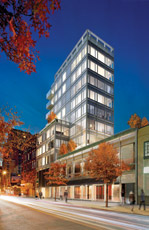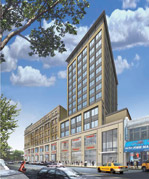|
COVER STORY, MARCH 2009
GREEN BUILDING CONCEPTS
How to save money while saving energy and going green.
By Myrrh Caplan
In today’s market, we are constantly faced with the challenge of balancing and demonstrating the upfront costs of building a sustainable commercial building with the long-term savings and benefits. The good news is that there is a growing body of research that demonstrates how savings can be attained in key areas, making the argument easier as time goes on.
 |
Richardson Lofts in Newark, N.J., a former jewelry factory, is seeking LEED-Silver certification.
|
|
For example, some of the most important benefits of a sustainable building relate to the people who work within it. Seventy-five percent of a building’s annual operating cost is directly spent on the salary and benefits for the people that work inside the building. Recent studies conducted by Vivian Loftness, FAIA from Carnegie Mellon University, as well as a collaborated report by Joseph Romm from the U.S. Department of Energy and William Browning from the Rocky Mountain Institute, prove that sustainable design can offer the benefits of reduced absenteeism, increased employee retention and improved worker productivity. Additionally, green buildings have been proven to reduce both illness-related absences and covert absences due to an employee’s dissatisfaction with the workplace. When workers are in the office, the implementation of green building practices such as natural lighting and controllability of temperature has been shown to increase task efficiency in employees. From a recruiting standpoint, young professionals today tend to consider a healthy, comfortable workplace as one of their employee benefits.
 |
350 West Broadway in Manhattan
|
|
Workforce aside, the remaining operating costs in a typical non-green building break down like this: 50 percent of the energy budget is on for climate control, 40 percent for lighting, and 10 percent for office equipment. In a green building, increased rents, increased occupancy, reduced churn, and real property value can also be viewed as benefits.
Green buildings tend to take in higher rents than their non-sustainable counterparts, which may also increase the amount of initial financing available. Despite these higher rents, tenants are eager to move into these buildings and, in many cases, are even willing to be put on waiting lists. This, in turn, causes less churn as the tenants that are able to secure a lease in a building are more likely to renew their leases for an additional term, rather than relocate. At the end of the day, buildings with sustainable designs demonstrate low operating costs and low vacancies, thus increasing the value of a building. A research report by Eichholtz, Kok & Quigley found that on average green buildings bring in $5 million more market value than their non-green counterparts.
Pro forma
Another tool to help evaluate savings is the pro forma, a master document that tabulates all costs associated with design and construction. Essentially, it is an innovative, holistic assessment of building costs that gives a concise dollar amount that can be used to approve or reject a project. The pro forma is able to analyze the bricks and mortar, costs of operation, maintenance, productivity, marketing, retention and eventually deconstruction, with practical monetary results for the full life cycle of the building.
The discussion between construction and operation costs tends to focus on energy efficiency; however, costs for energy and maintenance make up a small portion of the lifelong economy of a building. An overwhelming majority of the life-cycle cost of a project is typically post-construction, yet less than 3 percent of that is operational budgets.
 |
100 Park Avenue in Manhattan
|
|
Over the next 30 to 40 years, 50 percent of our nation’s building stock will need to be replaced or significantly upgraded to become more efficient. This is why it is so important when evaluating options for green building and renovations to consider if the materials being used are durable. The use of green building materials is only cost-effective if the materials used will not need to be replaced too soon.
Specialized green projects
With increasing proof about cost savings, as well as growing environmentalism that is being reinforced by the Obama administration, sustainability is reaching beyond construction of office space into many other uses:
• The institutional hospital room we’re used to is quickly becoming part of the past and a new “green” hospital room may be the wave of the future. This new concept room is being built to demonstrate that green materials and technologies are economically viable and readily available. It is also a response to studies that have shown that the design and dynamics of a hospital room can contribute directly to patient care and encourage the healing process, creating shorter patient visits and, in turn, increasing the hospital’s bottom line. The design eliminates materials that could possibly make inhabitants sick, reduces stress, and speeds up the healing process, while also allowing caregivers to be more efficient with less chance of error.
• Construction trailers, like those we use at Skanska, are using low VOC paints and materials, ensuring efficient water and energy use.
 |
Fordham Place in the Bronx
|
|
• Existing data centers and other high-energy consumption facilities are upgrading their systems to be more efficient and in the process, greening their workspaces.
• Mixed-use, transit-oriented developments — communities with homes, offices, restaurants, and retail amenities clustered to encourage pedestrian use — are seeing their values hold up better in this economy.
Overall, developing economical green solutions for clients can be executed efficiently in terms of cost, energy and timeframe. It is our job to provide customized, innovative, and environmentally responsible solutions for all facility types, including renovations and heavy civil construction, and to strive to meet the needs of the world today without jeopardizing the needs of the world tomorrow.
Myrrh Caplan is the national program manager of Green Construction at Skanska USA Building Inc.
Resource Conservation, Design Planning are Keys toEco-Friendly Landscape Architecture
Today, one of first things people ask me is: How can I be more efficient and environmentally responsible with my landscape design? People around the country, from the average homeowner to corporate property managers, are seeking landscape architecture solutions that are cost-effective, sustainable, low-impact and attractive for both residential and professional environments.
A thorough landscape design and build process should be committed to resource conservation, intelligent irrigation and biodiversity in plant life. The key to creating ecologically sensitive and economical outdoor solutions is involving your landscape architect in the process as early as possible.
It’s not enough to create a landscape that is environmentally friendly, which, of course, is the buzz phrase of the decade. The landscape also needs to be aesthetically pleasing with sound design principles that maximize efficiency. Early planning is very important to achieving well thought-out, eco-friendly and sustainable landscapes.
A landscape design plan that conserves water and reduces the use of pesticides and fertilizers is a good first step. Installation and proper management of underground irrigation and drip systems that control excessive watering is a great environmental and economic benefit. Rain gardens and water harvesting systems can be cost-effective ways to utilize water runoff and rain, thereby collecting, storing and cleaning water before allowing it to be released slowly back into the environment or used for consumption.
Additionally, utilization of porous or pervious materials for unplanted areas and walkways is important. Plant life that can collect water run-off and the use of pervious pavers, flagstone and gravel in walkways and other unplanted areas helps to collect rainwater, reduce water runoff and increase water absorption.
We recommend a biodiverse landscape design, as well as organic grounds and plant care management. A bio-diverse landscape supports a wide variety of life from plants and animals to insects and beneficial pollinators. Organic land care avoids synthetic fertilizers and pesticides, providing a safer environment for everyone.
Another design option on the rise is the utilization of green roofs and living walls. Green roof systems offer many public and private benefits and great design flexibility. Living walls are partially or completely covered with vegetation, providing visual interest.
From green roofs to beautiful landscapes without synthetic pesticides, we encourage an ecologically sound landscape design. Whether you are a homeowner or corporate building manager, select an experienced landscape architect that will be responsible for the design plan, landscape build and maintenance.
— Robert Schucker is president of Eco Earth Design and R&S Landscaping, based in Midland Park, N.J. |
©2009 France Publications, Inc. Duplication
or reproduction of this article not permitted without authorization
from France Publications, Inc. For information on reprints
of this article contact Barbara
Sherer at (630) 554-6054.
|
